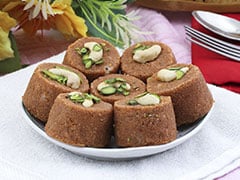Story ProgressBack to home
Vegetable Oil(वनस्पति तेल)
Hindi Name:वनस्पति तेल
Made by refining extracts of plants, vegetable oils are those which remain in liquid form at room temperature. Many plants produce oil but it is commonly extracted from seeds. Vegetable oil may be made from a single ingredient or a blend of many.
Refined oils are recommended for high-heat deep frying, whereas oils which are unrefined taste better when used in salads or other cold recipes.
- NDTV Food
- Nov 21 2014 13:20 IST
 Made by refining extracts of plants, vegetable oils are those which remain in liquid form at room temperature. Many plants produce oil but it is commonly extracted from seeds. Vegetable oil may be made from a single ingredient or a blend of many.
Made by refining extracts of plants, vegetable oils are those which remain in liquid form at room temperature. Many plants produce oil but it is commonly extracted from seeds. Vegetable oil may be made from a single ingredient or a blend of many.
Refined oils are recommended for high-heat deep frying, whereas oils which are unrefined taste better when used in salads or other cold recipes. Refined oils are usually lighter in color and bland in taste.
Types
The types of different oil depend on the various plant seeds from which they are extracted. The main varieties include: palm, soybean, sunflower, peanut, cotton, coconut, olive, corn oil, grape seed, hazelnut, linseed, rice bran, mustard, sesame, canola, pumpkin seed oil.
Usage
It is a basic ingredient in a variety of dishes, being used for sautéing, frying or dressing which help enhance the flavor of the recipe. It also serves an aromatic and textural purpose. Apart from being used as cooking oil it is also used in cosmetics, as a fuel and in pet foods.
Nutritional Value
High consumption of vegetable oils increases the chances of coronary heart diseases and cancer as compared to plant based oils. Excess consumption can also lead to weight gain.
How to Buy
Check the packaging before purchasing; avoid those varieties of vegetable oils which are partially hydrogenated or saturated. Opt for vegetable oils which are either unsaturated, monounsaturated or polyunsaturated as they contain good fats. Canola oil is lowest in saturated fats and is hence considered as the healthiest.
How to Store
Vegetable oils need not be refrigerated; they turn cloudy when kept in low temperatures. They can be stored in a cool, dark area where they can last up to 12 months.








